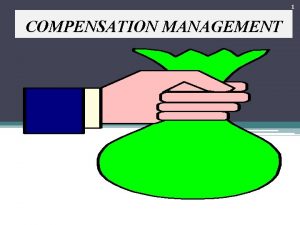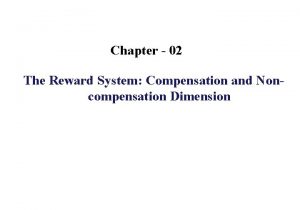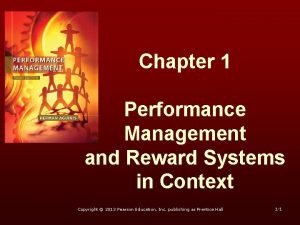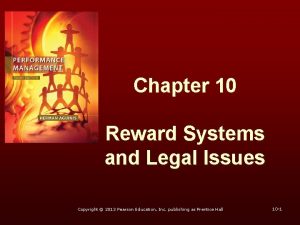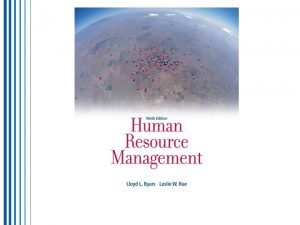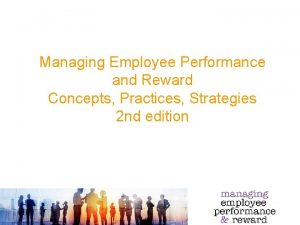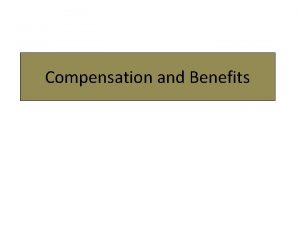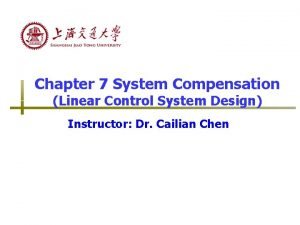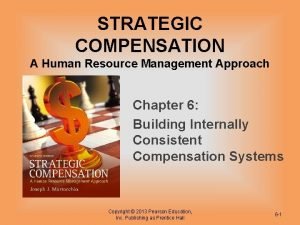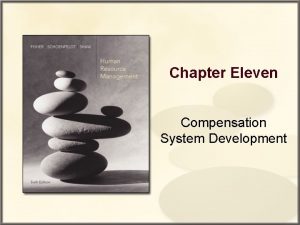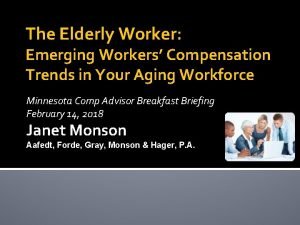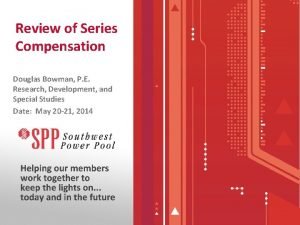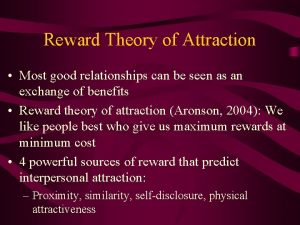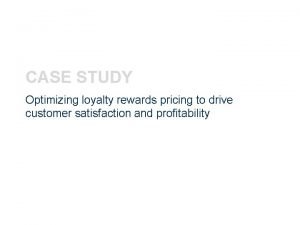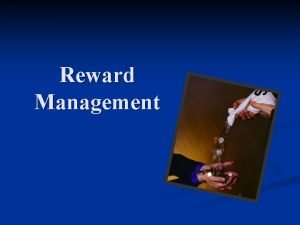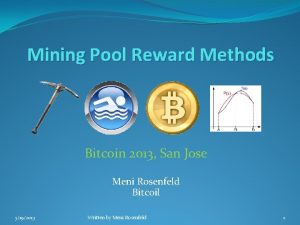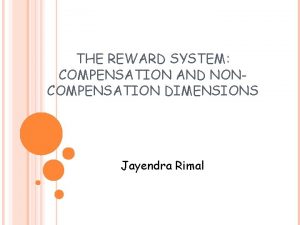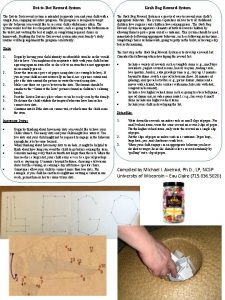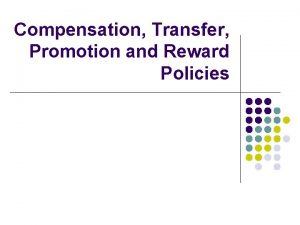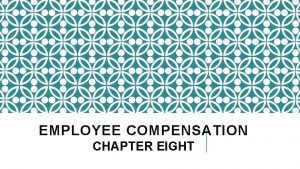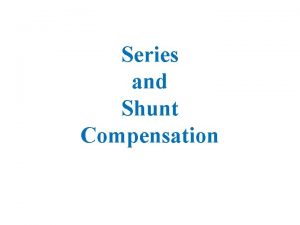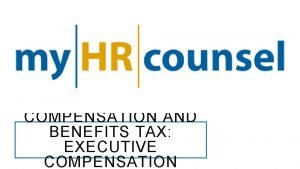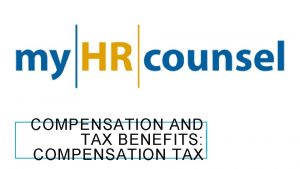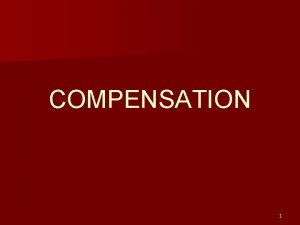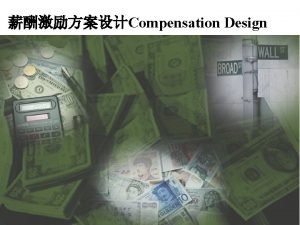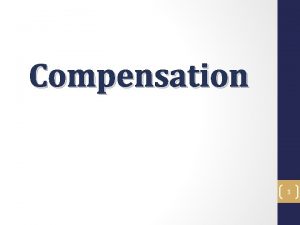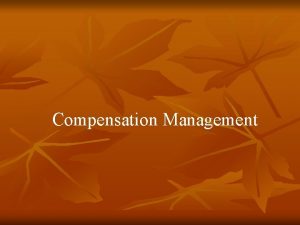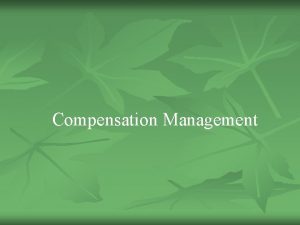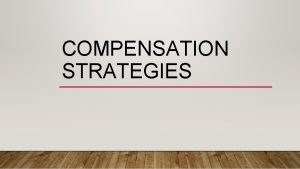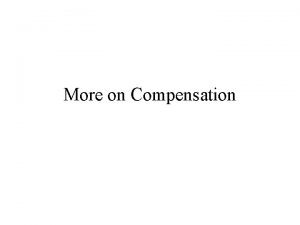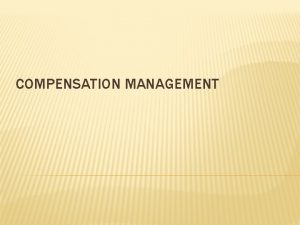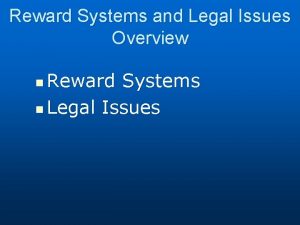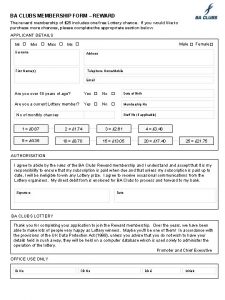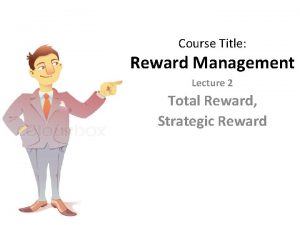Chapter 02 The Reward System Compensation and Noncompensation

























- Slides: 25

Chapter - 02 The Reward System: Compensation and Noncompensation Dimension

After studying this chapter, you should be able to know about; ü Opportunities available to employers to stimulate the productive efforts of each employees. ü The dimension of compensation system. ü The dimension of non-compensation system. ü The need to combine skillfully the compensation and non-compensation dimension into an effective reward systems.

Compensation Strategy ü Recognize and group compensation components so that they influence employee motivation in a positive manner and lead to improved organizational performance and profitability. ü People gain satisfaction from their work, but the kinds and the strengths of satisfaction have been difficult to identify, define, and measure with the degree of precision. ü Meanwhile, as the individual and the group of coordinate their needs and efforts, a third set of satisfactions develops.

Continued ü These satisfactions are the ones gained by the leaders or employers of the group- those who receive and offer some form of reward for the services provided by the individual and the group. ü Specifically, it focuses on monetary rewards paid either directly (base or cash incentives) or indirectly (employee benefits paid for by a employer).

Reward System ü An organization designs and implements a reward system to focus worker attention on the specific behaviors the organization considers necessary to achieve its desired objectives and goals. ü If rewards are to be useful in stimulating desired behaviors, they must meet the demands of the employees whose behaviors they are intended to influence. ü Because of the almost endless variety of human qualities, workplace requirements, and situational demands, the task of designing and managing a reward system so that it will benefit the organization is a difficult and complex undertaking.

Continued ü The reward system of an organization includes anything that an employee may value and desire and that the employer is able or willing to offer in exchange for employees contributions. ü All rewards that can be classified as monetary payments and in-kind payments constitutes the compensation system of an organization. ü Monetary payments can be in the form of coins or paper money, or in the less tangible form of checks or credit cards. ü All other rewards constitute the non-compensation system.

Compensation system The compensation system results from the allocation, conversion, and transfer of a portion of the income of an organization to its employee for their monetary and inkind claim on goods and services. As a medium of exchange, money enables an employee to purchase certain kinds and amounts of wide variety of goods and services available in the marketplace. Employee often have little or no opportunity for immediate monetary gain from an in –kind payment. Many employer provided in-kind payments, however, replace monetary payments of some amount of the employees’ income should the employees obtain similar goods and services elsewhere. Organizations purchase these required and usually desired goods and services for their members to take advantage of ; 1. Economic of scale available through group purchasing, 2. The benefits available through tax laws and regulations, and 3. Government laws requiring certain services.

(cont’d) The total compensation may be described in many ways, but the classification scheme used in this book is based on eight dimensions. The structuring of features, components and dimension into a compensation system is a job for the compensation specialist. This book will discuss in detail the process and practices related to the first compensation dimension, which provides for current spendable income. Change in legislation and court ruling also will influence the design of compensation program

Compensation Dimension A brief description of the eight compensation dimensions and some of their components will help the reader understand appreciate the complexity of a compensation system in a modern technology. 1. Pay for Work and Performance: ü Pay for work and performance includes money that is provided in the short term (Weekly, Monthly, and Annual bonuses/rewards) and that permits employees to pay for and contract for the payment of desired goods and services. ü Typical components within this dimension are base pay, premium and differential, short-term bonuses, merit pay, and certain allowances.

Continued 2. Pay for time not worked: ü Over the years, the number of hours worked per week and the number of days worked per year have decreased. ü During the past 40 years, workers have enjoyed more days off with pay for holidays, longer paid vacations, and paid time off for a wide variety of personal reasons. ü These components of pay for time not worked significantly increase labor costs and also enhance quality-of-life opportunities for most employees.

Continued 3. Loss-of –job Income Continuation: ü Job security is and always has been the primary consideration for most workers. ü They want assurance that their jobs and the income derived from working until they are ready to retire. ü A variety of components such as unemployment insurance, supplement unemployment benefits (SBUs), and severance pay help unemployed workers subsist until new employment opportunities arise.

Continued 4. Disability income continuation: ü The possibility always exists that a worker will incur health or accident disability. ü Because of these disabilities, employees are frequently unable to perform their normal assignments. ü Even so, individual and family living expenses continue, and medical, hospital, and surgical bills create additional burdens. ü Social security, workers compensation, sick leave, and short and long-term disability plans are examples of components that provide funds for employees who are unable to work for health-related reasons.

Continued 5. Deferred Income: ü Most employees depends on some kind of employer-provided program for income continuation after retirement. These programs are two basic reasons. ü First, most employees do not have sufficient savings at retirement to continue the lifestyles they enjoyed while working. Various kind of programs, such as Social Security, employer provided pension plans, savings and thrift plans, annuities, and supplemental income plans provide income after retirement. ü Second, Tax law and regulations make deferred income plans more appealing to many employees

Continued 6. Spouse (Family) Income Continuation: ü Most employees with family obligations are concerned with what might happen if they are no longer able to provide money that will enable their families to maintain a particular standers of living. ü Certain plans are designed to provide dependents with income when an employee dies or is unable to work because of total and permanent disability. ü Specific features within life insurance, pension plans, Social; Security, Workers’ compensation, and other related plans provide income for the families of employees when these conditions arise.

Continued 7. Health, Accident, and Liability Protection: ü When a health problem occurs employees must be concerned not only with income continuation, but also with payment for the goods and services required in overcoming the illness or disability. ü Organizations provide a wide variety of insurance plans to assist in paying for this goods and services. ü In recent years, the cost of medical-related goods and services has increased at a greater rate than almost other goods and service desired or required by employees.

Continued Income Equivalent Payment: ü A final set of compensation components may be grouped under the title of income equivalent payments. ü Many of these components are frequently called perquisites or Perks. ü Employee usually find them highly desirable, and both employers and employees find certain tax benefits in them. ü Some parks are tax free to employees and tax deductible to employers. ü In recent years, the Internal Revenue Service (IRS) has required that employer costs for specific portion of certain parks be considered earned income to employees.

Non-compensation System The other part of the reward system consists of non-compensation rewards. ü These rewards are much more difficult to classify and their components are far more complex than is the case for compensation rewards and components. ü In fact, Any activity that has an impact on the intellectual, emotional, and physical well-being of the employee and is not specifically covered by the compensation system is part of the non-compensation reward system.

Continued ü An in-depth analysis of the seven non-compensation dimensions identified in rewards these are; 1. Enhance Dignity and Satisfaction from work performed: ü Possibly the least costly and one of the most powerful rewards an organization can offer to an employee is to recognize the person as a useful and valuable contributor. ü This kind of recognition leads to employee feelings of self-worth and pride in making a contribution. ü Every compensation and non compensation reward component should carry with it the message, “ We need you and appreciate your efforts. ”

Continued 2. Enhance psychological Health, Intellectual Growth, and Emotional Maturity: ü Considering the number of hours a person spends on the job, on travel to and from the work site, and off the job in attempting to resolve job-related problems, work obviously has a great effect on the health of employees. ü Health related problems frequently receive minimal attention until a serious problem occurs. ü Once this happens, however, it overrides all other employee concerns and activities. ü Modern health practices recognize the direct relationship between the physiological health and intellectual and emotional well-being of each individual. ü Provision of safe equipment a work environment that is as risk free as possible; minimization of noxious fumes; avoidance of extreme heat, cold, and humidity conditions, and elimination of contract with radiation, carcinogens and other disease related materials and substances-these conditions are expected by all employees.

Continued ü As important as these physical conditions are more and more attention is being focused on the emotional strains that result from the extreme specialization of work assignments and the complex interactions caused by these specialization. ü Although these universal problems are almost impossible to overcome, management can recognize their existence and can take action to limit their negative influence on the performance of each employee. 3. Promote constructive Social Relationships with Coworkers. An old adage states that, “ One man is no man. ” Although there are constant reminders of what one dedicated person can achieve, there are even more reminders that one human alone is weak. In this world of extreme specialization, people need and rely on other people more than ever. A workplace environment where trust, fellowship, loyalty, and love emanate from the top level of management to the lowest level of the organization promotes the kinds of social interaction most people need in order to thrive. The move toward team-based operations is an example of what organizations are doing to improve social interactions among employees

Continued 5. Design Jobs That Require Adequate Attention and Effort: ü Specific attention has been focused on scientific management efforts to specialize work assignments that were developed in the last quarter of the nineteenth centaury. ü Many employees soon become bored and dissatisfied. Work-related anxieties and frustration produced employee behavior that led to declining performance. ü Employee turnover, absenteeism, tardiness, minimal concern for quality or productivity, waste of physical resources, and even theft and malicious damage were behaviors attributed to unacceptable workplace and job design. ü Managers are being taught to instruct workers to do their jobs and then to leave them alone to perform their assignments in their own ways. ü This does not mean that managers must abdicate supervisory responsibilities. Rather, they must learn to recognize when to provide needed support, When to tell employees what they are doing right, and when to assist them in correcting their errors.

Continued 6. Allocate Sufficient Resource to Perform Work assignments: Requiring employees to perform assignments for which they have neither the knowledge nor the skills opens the door or for problems. Not only is the organization likely to suffer because of outcome failures, but employee job-related interest and satisfaction are apt to break down because of the likelihood or inevitability of failure. To make work a satisfying, even exhilarating experience, employees must not be placed in a no-win situation. This doesn’t mean that an employee should not be expected to stretch and put forth sufficient effort to meet workplace obligations.

Continued 7. Grant Sufficient Control over the Job to Meet Personal Demands: From the 1950 s to the present time, behavioral scientists have discussed the need to grant employees greater opportunity to participate in organizational decision-making process. A few people in every organization want to tell top management how to run the organization. Between these two extremes is a wide variety of demands for a greater voice in determining how to perform assignments.

Continued 8. Offer Supportive Leadership and Management: This dimension is difficult to separate from all other non-compensation rewards, but it is so important that is must be recognized as a unique dimension of the noncompensation rewards and not just a component of the other factors. Employee faith and trust in management assist in establishing a workplace environment where job security becomes accepted, where social interaction thrives, and where work satisfaction is possible. Supportive leadership is demonstrated in many ways: skill and inters in coaching and counselling. Praise for a job done, and constructive feedback leading to improvement of job performance. The selection, training, and promotion of individuals who will later become effective leaders and managers are the cost components of this dimension.

Thank you so much for your nice cooperation. Any Question? ? ?
 What is compensation management
What is compensation management Compensation and non compensation dimensions
Compensation and non compensation dimensions Performance management and reward
Performance management and reward Reward system and legal issues
Reward system and legal issues Role of reward system
Role of reward system Cpcs salary table 2021
Cpcs salary table 2021 Othello summary act 2
Othello summary act 2 Managing employee performance and reward
Managing employee performance and reward Celebrating performance
Celebrating performance Compensation system meaning
Compensation system meaning Lead compensator
Lead compensator Building internally consistent compensation system
Building internally consistent compensation system Components of compensation
Components of compensation Series compensation system market trends
Series compensation system market trends Qqqnn
Qqqnn Pe bowman
Pe bowman Reward from god
Reward from god Where is the reward center of the brain
Where is the reward center of the brain Keuntungan join multibeauty
Keuntungan join multibeauty Risk reward
Risk reward Reward theory of attraction psychology
Reward theory of attraction psychology Profit are the reward for
Profit are the reward for Loyalty spaarsysteem
Loyalty spaarsysteem The passion pyramid
The passion pyramid Components of reward
Components of reward Reward method pps
Reward method pps
